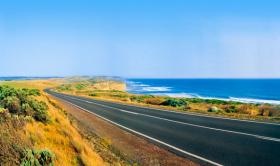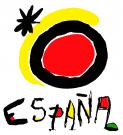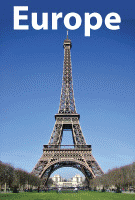
AUSTRALIA
Five Scenic Australian Road Trips

From mountain to mulga... enjoy five epic Australian journeys on roads much less travelled, but far more rewarding.
To drag your fingertips across Australia’s textures and grasp its scale, drive. From the soft, red sandhills of the centre to the sharp-edged sea cliffs of the coast, the changes come at a leisurely pace that’s best appreciated travelling, earthbound, at a tempo to match. Through the
windscreen of a car every wrinkle and groove of the continent’s weatherbeaten geography can be seen and savoured.
Three of these long drives are routes between major cities of the east and south. None of them is the most direct, but that’s not what makes an epic. 
The suggested routes favour corners over straights, two-lane over freeway, hills over plains and scenery over signage. The remaining two are different. One is a circuit of Tasmania. This verdant island packs more wonderful driving into its compact dimensions than any other part of Australia; from its pretty capital to the majestic tree cathedrals of its wild forests. It’s hard to imagine a drive more different from lapping Tassie than the Gibb River Road in the north of Western Australia.
Dusty and often corrugated, prudence rather than panache is needed behind the wheel, but it will be rewarded with seeing some of the most remarkable places this remote corner of the country has to offer. Before setting out on these trips, be sure to buy a good quality road map. The distances are for the basic route described (rounded to the nearest 100km), not taking any side trips into account.
1. Murrary Meander Adelaide to Canberra: 1800km Tracing the Murray River from muddy mouth to mountain source is a drive to remember. There are relics of colonial-era endeavour, places where agricultural abundance is coaxed by precious water from arid earth, vibrant towns, sleepy backwaters, cliffs carved by the wandering river, river flat forests and, finally, the big river’s small beginnings beside the continent’s highest mountain. Although the suggested route could be covered more quickly, five days is a sensible minimum to allow.
From Adelaide head first to Goolwa, the town near where the Murray empties from Lake Alexandrina into the Southern Ocean. Skirt the lake, via pretty Strathalbyn, to catch the ferry across the river at Wellington. Through Tailem Bend, Murray Bridge and Swan Reach to the run-down old river-steamer stop at Morgan, then Waikerie, Loxton, Berri and Renmark, the river gradually changes from a place for play to a source of income. Irrigation has made these upriver towns greenly productive, but for a reminder of how naturally dry this part of Australia is, take the dirt road north of the river from Renmark to Wentworth, where the Darling River joins the Murray. Nearby Mildura is a lively regional centre that has developed a reputation for fine food thanks to people such as Stefano di Pieri. Dinner at his excellent restaurant, Stefano’s in Seventh Street, is a treat and his adjacent cafe is a fine place to breakfast before hitting the road again. Cut across New South Wales to Euston and Robinvale, then continue on the Victorian side to Echuca.
 This town was once the turnaround point for the Murray’s 19th-century paddle-steamers. You can take a short cruise on a puffing survivor. At Yarrawonga, take the road north of Lake Mulwala to Corowa, site of several conferences that eventually led to Federation in 1901. On the other side of the river, Rutherglen, known for its wines, especially fortifieds, is another good place to stop, rest, eat and drink. After passing through Wodonga, turn right in Albury for Hume Weir. The beautiful road to Walwa follows the south bank of the Murray. Make the short detour into Corryong for good food and espresso coffee at the Pepper Leaf Wine Bar & Restaurant before heading into the hills beyond Khancoban. Tom Groggin is a locality, not a town, and your last chance to dip a toe in the Murray. The road to Canberra, over Dead Horse Gap and through Thredbo, in Mount Kosciuszko’s shadow, then Jindabyne and Cooma, is a real driver’s delight, and a great way to end this meander.
This town was once the turnaround point for the Murray’s 19th-century paddle-steamers. You can take a short cruise on a puffing survivor. At Yarrawonga, take the road north of Lake Mulwala to Corowa, site of several conferences that eventually led to Federation in 1901. On the other side of the river, Rutherglen, known for its wines, especially fortifieds, is another good place to stop, rest, eat and drink. After passing through Wodonga, turn right in Albury for Hume Weir. The beautiful road to Walwa follows the south bank of the Murray. Make the short detour into Corryong for good food and espresso coffee at the Pepper Leaf Wine Bar & Restaurant before heading into the hills beyond Khancoban. Tom Groggin is a locality, not a town, and your last chance to dip a toe in the Murray. The road to Canberra, over Dead Horse Gap and through Thredbo, in Mount Kosciuszko’s shadow, then Jindabyne and Cooma, is a real driver’s delight, and a great way to end this meander.
DRIVE: an effortless, Australian-made mile-eater such as the Ford Territory.
STAY: Mildura, Echuca or Rutherglen.
2. Brine & Wine Melbourne to Adelaide: 1000km Built to honour Australian soldiers who died in World War I and to provide employment for those who returned, the Great Ocean Road is one of the world’s most unusual war memorials. Its 243km length faithfully follows the rugged Victorian coastline through seaside settlements and past spectacular natural landmarks.Reaching the beginning involves a dull 110km freeway drive from Melbourne to Geelong, worth a pause for its attractive waterfront area, and Torquay.
But between Torquay and Lorne, the road’s magic begins to unfold.
Eat at either Lorne or Apollo Bay in preparation for walking to the lookouts over the majestic, sea-carved limestone formations, including the famous 12 Apostles, to come on the next leg of the drive, through Port Campbell to Warrnambool. A little further on, strike inland from Port Fairy to take backroads (the C184 and C176) to Heywood. Join the Princes Highway and drive to Mount Gambier. There’s a tough choice to be made at this point between more water, and wine. Sticking by the coast leads to the town of Robe, then from Kingston SE to Meningie along the inland fringe of The Coorong, a desolately beautiful lagoon.
After Meningie turn at Wellington for the drive to Adelaide through the rolling hills around Strathalbyn, or continue to Tailem Bend to join the M1 freeway.
Striking north from Mount Gambier, through Penola and Naracoorte to Keith, will take you through the renowned Coonawarra and Padthaway wine regions, birthplaces of many of Australia’s best reds. To not stop for a sample sip would be foolish. At Tailem Bend there are the same options as for those who drove up the coast. There’s a straight and dull drive into Adelaide, or the scenic route through Wellington and Strathalbyn.
DRIVE: Holden Commodore Sportwagon, Mazda 6 wagon or anything that’s fun to drive and able to easily swallow a few dozen of the Coonawarra’s finest.
STAY: Port Fairy, Robe or Naracoorte.
3. Lap of Tassie Hobart to Hobart: 1000km It’s no longer a secret that the island state has some of the world’s most wonderful roads, thanks largely to Targa Tasmania, the tarmac rally run annually since 1992 and loosely modelled on Sicily’s legendary and long-gone Targa Florio. But winding roads are only part of Tasmania’s charm. There’s a spectacular coastline, unspoiled wilderness, remnants of Australia’s convict past, as well as pretty cities and towns to see. This route begins and ends in Hobart, but both Launceston and nearby Devonport, where the car-carrying ferries dock, are viable starting points. Three days are enough to complete the circuit, but five or six are better. From Hobart take the A3 to Sorell. For a 73km each-way side trip to Port Arthur, turn right. Alternatively, drive on through Triabunna and Swansea to Llandaff, jumping-off point for the drive to the Freycinet Peninsula.Continuing north up the east coast, be sure to turn left for the Elephant Pass, a Targa Tasmania stage, leading to St Marys.
There are five more stages to enjoy on the road via St Helens and Scottsdale to Launceston. From here head west to Deloraine, Railton and Sheffield to pass the northern edge of the wild Cradle Mountain and Lake St Clair National Park. The road, via Rosebery and Zeehan, to Strahan on the west coast is brilliant. Stay overnight and take a cruise up the eerily inky Gordon River. The challenging climb out of Queenstown through a bare, barren moonscape, a legacy of the town’s mining past, is yet another Targa stage. And the drive back east, through Derwent Bridge, Hamilton and New Norfolk to Hobart, contains several more. In Hobart, stay somewhere close by the dock area. It’s the place to find fine food and woodcraft, something of a Tasmanian specialty.
DRIVE: a real sports car, something with pedigree handling, such as a Porsche 911 (which has a great Targa track record) or a Mazda MX-5.
STAY: Freycinet, Launceston or Strahan.
 4. King Gorge
Derby to Kununurra: 700km
Don’t be deceived by the relative shortness of this trip compared with the others; this is easily the most serious drive of them all. Travelling the Gibb River Road across The Kimberley, like any journey in remote Australia, involves Boy Scout-level preparedness. But the rewards are truly exceptional. There’s a magic to this empty, and often dusty landscape, dotted with hidden gorges, pools and waterfalls.
4. King Gorge
Derby to Kununurra: 700km
Don’t be deceived by the relative shortness of this trip compared with the others; this is easily the most serious drive of them all. Travelling the Gibb River Road across The Kimberley, like any journey in remote Australia, involves Boy Scout-level preparedness. But the rewards are truly exceptional. There’s a magic to this empty, and often dusty landscape, dotted with hidden gorges, pools and waterfalls.
And the folk who live here are always welcoming. Directions are simple. Drive 5km out of Derby (there’s only one highway) and turn left onto the GibbRiver Road. Almost 700km later, turn right when you reach the bitumen for the short 50km-plus drive into Kununurra. You’ll drive further than the 700km of this basic route, as the Gibb River Road is simply a starting point for side trips to The Kimberley’s remote beauty spots. How much further is your choice. From Derby to Kununurra, the publicly accessible gorges and pools are Windjana Gorge and Tunnel Creek, Lennard Gorge, Bell Gorge, Adcock Gorge, Galvans Gorge, Manning Gorge and Mt Barnett Gorge. Not all have camping grounds.
Choosing to stay under a roof at one of the stations or sanctuaries off the Gibb River Road that have accommodation means more than not having to pitch a tent or unroll a swag. Most allow their guests access to places that aren’t open to the public and some offer organised outdoor activities. Best known is El Questro, near the northern end of the road. Check out others on www.gibbriverroad.net The Gibb River Road is usable from around May – when post-wet season grading has smoothed it out – to October. Driving at dawn, dusk or night isn’t wise, as the road is mostly unfenced and wildlife can be an issue. Carry spare fuel and water, and stay with your vehicle should trouble strike. Listen carefully to local advice on where it’s okay to swim and where it’s not.
DRIVE: anything wearing a Toyota LandCruiser badge, preferably diesel for longer driving range and better fuel availability.
STAY: anywhere pitching a tent is permitted.
5. The Other Way Sydney to Brisbane: 1100km There’s an alternative way to drive from Sydney to Brisbane. It wriggles between the slow-moving Pacific Highway on the coast and the dreary New England Highway inland. These often empty roads swoop and dive over the wrinkles of the Great Dividing Range and occasionally go through charming, out-of-the way country towns. Allow at least two days for this one. Escape Sydney on the M2 tollway.
At Windsor, find the right turn onto Putty Road. Long a favourite of motorcyclists, this road wends mostly through national park wilderness to Singleton in the Hunter Valley. Then aim for Gresford, Dungog and Stroud Road, turning left here for Gloucester. Hunger, thirst or coffee withdrawal are best taken care of in Dungog or Gloucester – both have good cafes. Heading out of Gloucester towards the Barrington Tops National Park, find the right turn onto Thunderbolts Way. Named for 19th-century bushranger Fred Ward, known as Captain Thunderbolt, this road was dirt until not so long ago. These days it’s bitumen all the way, but relatively unknown. Be sure to pause for the view from Carsons Lookout between Gloucester and Nowendoc, before pressing on for Walcha through forest and farmland.
This quiet town has hotels, motels and B&Bs. From Walcha aim for Uralla, then take the New England Highway to Armidale. Leave the highway there and find the road that winds through Ebor and Nymboida to Grafton. Take the Summerland Way to Casino, turn left on the Bruxner Highway towards Tenterfield, but leave it again near Mummulgum for the pretty road north to Woodenbong. Join the winding Mount Lindesay Highway to cross the NSW-Queensland border and head, via Beaudesert, to Brisbane.
DRIVE: Mercedes-Benz C-Class, Volkswagen Golf or something else smooth-riding, yet agile.
STAY: at Walcha – and for breakfast, try Café Graze.














 Copyright © 2006-2022
Copyright © 2006-2022